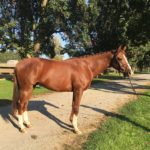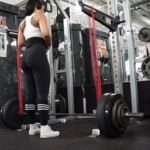Race #3 means a new horse. If your horse clears the Foresthill vet check, as the sun goes down he’ll get new life. And the last third of trail is much more about going down than the other pieces – only a few wicked hills interspersed with a lot of long descents, switchbacks and relatively-flat lands.
The trick with the last bit is that it gets dark. Depending on how fast you’ve been going, you’ll be riding in the dark for five to ten hours. There is, in theory, a moon. But it has to come up high enough for its light to reach into the canyons. And trees are pretty effective at blocking moonlight.
Horses can see in the dark – not as well as cats, of course (and there are some of those out there with you), but way better than we humans can. Unfortunately it’s hard for us to trust our equine partners at that level, even after nearly 70 miles. So some horses wear necklaces of glow lights, some riders wear headlamps, some have both. If you were to hover over this section of the American River canyon on a certain summer’s evening, you’d see some pretty odd little chains of light trickling along the ground.
This leg also involves crossing the American River. The flow is held down so that the horses can ford it without tremendous risk, but it is a river. A small horse (among Arabians we’re talking 14 hands or so – 56 inches where the neck meets the back) will be in half way up his side, the rider will get wet from the knee down if he stays on. It’s treacherous and cold and noisy. Oh, and remember that it’s dark. Interestingly enough, there’s always a party going on at the river crossing. A couple of sober folks take your rider number as you start into the water, behind them is what looks a lot like a San Diego State kegger.
There are two vet checks in the last part of the ride, both of them lit like airports and as you get close and see those beacons shining out of the dark you really get a lift. At Francisco’s (the first one) they serve all kinds of baked goods. You can have a slice of lemon cake or cherry pie after covering 83 miles. I don’t recommend it.
The second vet stop is called Lower Quarry and it is a cold, desolate place that everyone is really anxious to get out of because the finish is only eight more miles. As you leave this last check, you trot up a fire road and cross Highway 49, wind quickly along a single track that is beautiful in the day and drop down suddenly onto No Hands Bridge. No Hands is an iconic element of the ride. Originally built as a railroad bridge for transporting quarried rock, it is gracefully arched and completely trot-able. If you drop your reins, wave your arms in the air and whoop as you cross No Hands (?cause look ma, no hands!) and you get a goose out of your pony you are in good shape to swoop on into the finish.
Six miles later you and your horse wander into the bright lights and cheering of the fans at the finish of the Western States Trail Ride. Accomplished, tired and proud..and now sadly afflicted with Tevis Fever.







